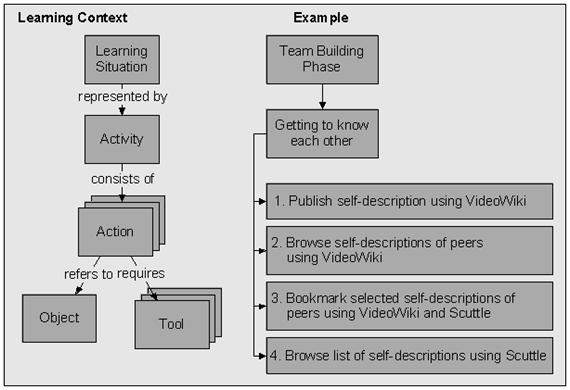Learner interaction scripting language
 From EduTechWiki - Reading time: 2 min
From EduTechWiki - Reading time: 2 min
Definition[edit | edit source]
The Learner Interaction Scripting Language (LISL) is a design language model for creating, managing, maintaining, and learning about learning environment design. It is complemented by a proof of concept, the Mash-up Personal Learning Environments (MUPPLE) platform.
See also: Personal learning environment, CSCL script
The language[edit | edit source]
“Basically, we break down the learning context into situations which describe the physical and social environment of learners. In such a situation, a learner is engaged in a so-called activity which consists of actions and includes tools, artefacts, and other actors (facilitators or peers). In contrast to instructional design, these actions represent more prominently commands for self-organising the learning process.” (Wild et al. 2008: 6)
Example[edit | edit source]
Copyright notice: The following example (figures) were copied from Wild et al. 2008
- Lines 1 to 7 define abstract actions
- publish, bookmark, all self-description and my list of self-descriptions are associated with a tool
- browse, self-description and selected self-description are defined with a tool
- Lines 8 and 9 define web-based tools (that can be later used in actions).
- Lines 10-13 define actions that make up the activity.
Discussion[edit | edit source]
Daniel K. Schneider thinks that LISL/MUPPLE is quite a promising approach since it combines 2 features:
- Use of various on-line services, e.g. from the every increasing List of web 2.0 applications
- Integration of personal learning environment features (the learner can choose his own tool from some activities allow).
Links[edit | edit source]
- iCamp Project site for ICamp.
Bibliography[edit | edit source]
- Wild Fridolin; Felix Mödritscher and Steinn Sigurdarson (2008). Designing for Change: Mash-Up Personal Learning Environments, eLearning Papers. http://elearningpapers.eu, 9. ISSN 1887-1542. Abstract - PDF
- Mödritscher, F., Neumann, G., García-Barrios, V.M., and Wild, F. (2008). A Web Application Mashup Approach for eLearning. Proceedings of the OpenACS and .LRN Conference, pp. 105-110.
- Wild, F., and Sigurdarson, S.E. (2008). Distributed Feed Networks for Learning. In: The European Journal for the Informatics Professional.
 KSF
KSF
